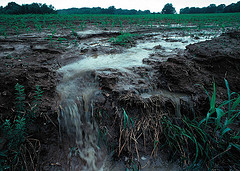By Chuck Gill, Penn State

UNIVERSITY PARK – A grant of $484,000 will support a joint Penn State/U.S. Department of Agriculture-Agricultural Research Service project designed to help farmers improve water quality by making better decisions about when and where to apply fertilizer.
The funding, from USDA’s Agriculture and Food Research Initiative, will enable scientists to develop the Fertilizer Forecaster, a Web-based decision-support tool that producers can use before applying fertilizer to assess the risk of nutrients running off in surface water.
“Mandated nutrient-management plans are designed to provide guidance for farmers that can help them make prudent decisions,” said project director Patrick Drohan, assistant professor of pedology in Penn State’s College of Agricultural Sciences.
“But these plans may not provide the day-to-day support required to make operational decisions — particularly when and where to apply nutrients in the short term,” he said. “These short-term decisions can make the difference between whether the nutrients impact water quality or are efficiently utilized by crops.”
Rainfall that infiltrates the soil on the heels of a broadcast fertilizer application is beneficial, Drohan explained, because it washes soluble nutrients into the soil where they can be used by crops. Conversely, rainfall events that generate runoff shortly after fertilizer applications can lead to significant nutrient loss from the site, ultimately polluting bodies of water, such as streams, rivers and the Chesapeake Bay.
“Our goal is to develop a research-driven support tool for nutrient management that identifies the relative probability of runoff or infiltrating events in Pennsylvania landscapes,” said project co-director Anthony Buda, research hydrologist with USDA-ARS. “This tool will support field-specific decisions by farmers on when and where to apply fertilizers and manures over 24-, 48- and 72-hour periods.”
The researchers cited five project objectives:
— Monitor agricultural hillslopes in watersheds representing four of the five physiographic provinces of the Chesapeake Bay basin.
— Validate a high-resolution mapping model that identifies soils prone to runoff.
— Develop an empirically based approach to relate state-of-the-art weather-forecast variables to site-specific rainfall infiltration or runoff occurrence.
— Test the empirical forecasting model against alternative approaches to forecasting runoff occurrence.
— Recruit farmers from the four watersheds to use Web-based forecast maps in daily manure and fertilizer application decisions.
“Data from on-farm trials will be used to assess farmers’ fertilizer, manure and tillage-management decisions before and after conscientious use of the Fertilizer Forecaster,” Drohan said. “This will help us to understand not only the effectiveness of the tool, but also characteristics of farmers with the greatest potential to benefit from such a tool.”
He added that feedback from on-farm trials will be used to refine a finished tool for delivery to the Pennsylvania Conservation Commission.
“We hope that the Fertilizer Forecaster will serve as the basis for state, regional and national changes in nutrient-management planning,” said Buda.


